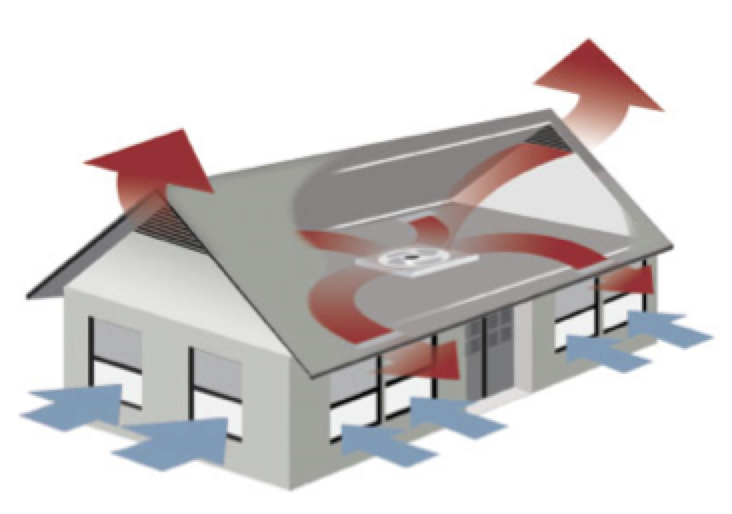One of the last items still contributing to major energy losses in our new homes is air leakage. But as we build tighter, the typical adage “fresh air by leakage” is no longer a viable ventilation strategy. With mandatory blower door testing on the horizon for future code cycles, addressing how we ventilate our homes is a priority. In this article, I will outline the four most common “ventilation strategies” we run into for residential construction, how they work and whether they are actually providing quality outside air.
Bathroom Exhaust Fans
The industry standard in California is installing bathroom exhaust fans that run continuously at a low rate (cubic feet per minute or CFM), ramping up when the restroom is in use. That continuous fan is creating negative pressure in the home and pulling in “fresh” outdoor air. That outdoor air is pulled into the home through building leakage. Yes, if a window or door is open, air will be pulled through it, but heat is also being lost through that same opening. With new-construction homes and efficiency retrofits becoming tighter, exhaust ventilation is becoming less effective. However, this IS an indoor ventilation strategy.
Whole House Fan
A whole house fan (WHF), typically installed in the ceiling, uses an exhaust fan to evacuate the air inside your home to the outside. This creates negative pressure inside the home and pulls in… sound familiar? A whole house fan is using the same principles as bathroom exhaust fan induced ventilation but with a larger fan. The benefit of a WHF is to use it for night ventilation cooling: turning it on when the outdoor temperature is below the indoor temperature and opening the windows to quickly cool off a home. The unit itself and its operation are affordable when compared to air conditioning, but this only works in climates with low humidity and a cool evening/night temperature.
This SHOULD NOT be used as a continuous indoor ventilation strategy. The major disadvantage is that when used for regular ‘ventilation’ (vs. summer night vent cooling), a WHF brings in unfiltered, often “dirty” air depending on what leakage it is being drawn through (your crawl space?). This can result in poor indoor air quality.
Powered Attic Fan
Similarly, a powered attic ventilator - or attic fan - regulates the heat level of a building's attic by exhausting hot air. Working along the same principle as a whole house fan, an attic ventilator exhausts air from inside to out – however, it only exhausts from the attic space and not the whole home. A thermostat is used to automatically turn the fan off and on, though sometimes a manual switch is used, and the fan can be gable mounted or roof mounted. The benefit of an attic fan is that when a home’s attic is insulated at the ceiling (rather than the eaves), reducing the temperature of the attic will reduce the heat gain you feel through your ceiling. This can be a cost-effective solution to helping cool off homes that experience high solar gains and hot ambient temperatures. It is not something that can be used for code compliance and IS NOT an indoor ventilation strategy.
Heat/Energy Recovery Ventilator
Lastly, whole house ventilation using a balanced system, ideally a Heat Recovery Ventilator (HRV) or Energy Recovery Ventilator (ERV), is the most effective system when addressing a home’s outside air needs. These systems supply and exhaust air at the same rate, usually at a low CFM so occupants don’t feel a draft or hear the system. The HRV or ERV device uses a heat exchanger to temper the incoming fresh air with the heat or coolth of the exhausted air, helping maintain a stable indoor temperature. Additionally, an ERV is capable of transferring moisture between supply and exhaust air – a useful feature in dry climates.
Depending on the model of the system installed, you can have a variety of filters installed to improve the quality of air brought into the home. These systems run continuously and work in tandem with your HVAC system but are an entirely separate system, and you are able to receive compliance credit with these systems. Balanced ventilation systems come in a variety of shapes and sizes that can be tailored to fit your home’s design and needs. At In Balance, we highly recommend including HRV or ERV in your new home designs and potentially retrofits as well!




